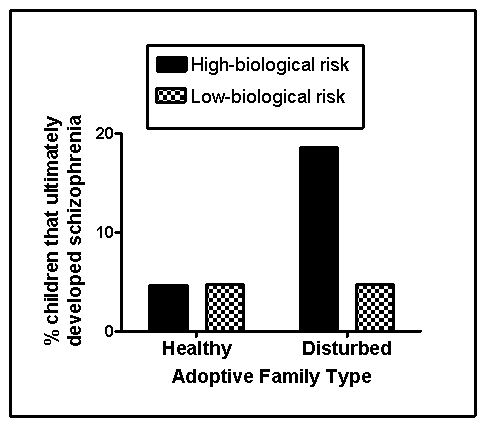Use the following to answer questions
Scenario II
The following scenario presents fabricated data consistent with the results of the following study:
Tienari,P. ,Wynne,L.C. ,Sorri,A. ,Lahti,I. ,Läksy,K. ,Moring,J. ,& ...Wahlberg,K.(2004) .Genotype-environment interaction in schizophrenia-spectrum disorder: Long-term follow-up study of Finnish adoptees.The British Journal of Psychiatry,184(3) ,216-222.doi:10.1192/bjp.184.3.216
Schizophrenia affects approximately 1% of the general population and is characterized by the profound disruption of basic psychological processes;a distorted perception of reality;altered or blunted emotional affect;and disturbances in thought,motivation,and behavior.The symptoms of schizophrenia are varied and are typically classified as either positive or negative.Positive symptoms of schizophrenia refer to thoughts and behaviors typically not observed in those without the disease and can include things like delusions (patently false beliefs) ,hallucinations (false perceptual experiences) ,and disorganized speech.Negative symptoms of schizophrenia are deficits or disruptions in normal behaviors,such as social withdrawal.Cognitive deficits in executive functioning,attention span,and working memory may also be observed.
The symptoms of schizophrenia usually begin in late adolescence and the disease has a strong genetic component.Over the years,a number of biological factors have been linked to schizophrenia,although none alone adequately accounts for the disorder.One such example is the dopamine hypothesis,which states that schizophrenia is related to an excess in dopamine activity.Another theory points to enlarged brain ventricles and progressive cortex tissue loss as predictive of schizophrenia.Although only a minority of persons with schizophrenia have enlarged ventricles,this structural anomaly can appear in those without the disease,and dopamine antagonists may also produce this effect.
Although research into the environmental determinants of schizophrenia has focused largely on the prenatal environment,psychological and social factors also contribute.Tienari and colleagues (2004) compared the risk of developing schizophrenia in children adopted into healthy versus disturbed families,the latter characterized by extreme conflict,volatile relationships,and communication deficits.Some of these children under investigation were identified as at-risk genetically for schizophrenia because their biological mothers were schizophrenic.The remainder were classified at low risk.The investigators utilized a longitudinal design and obtained the diagnostic status of the children with respect to schizophrenia when they reached young adulthood.Fabricated results consistent with this study are shown in Figure 15.2
Figure 15.2 
-(Scenario II) The results shown in Figure 15.2 demonstrate that:
Definitions:
Regulatory Control
The oversight and enforcement of rules and regulations by a governing body to ensure adherence to lawful standards and protect public interests.
Sole Proprietor
The single owner of an unincorporated business, personally responsible for all debts and obligations of the business.
Good Will
The favorable reputation of a business that adds to its value, often considered an intangible asset.
Partnership
A lawful business arrangement involving two or more people who divide management responsibilities and profits.
Q6: Research indicates that hospitalizing people for mental
Q22: Thinking and writing about stressful events improves
Q28: The first episode of schizophrenia typically occurs
Q29: Often,the decision to engage in risky sex
Q42: In most U.S.states,psychologists can both prescribe medication
Q77: Antidepressants are effective in treating unipolar and
Q111: Claustrophobia is the fear of:<br>A)heights.<br>B)enclosed spaces.<br>C)public places.<br>D)bridges.
Q132: Which characteristic is a sign of illness?<br>A)high
Q136: The antidepressant Wellbutrin blocks the reuptake of:<br>A)serotonin.<br>B)serotonin
Q158: Benzodiazepines exert their antianxiety effects by enhancing